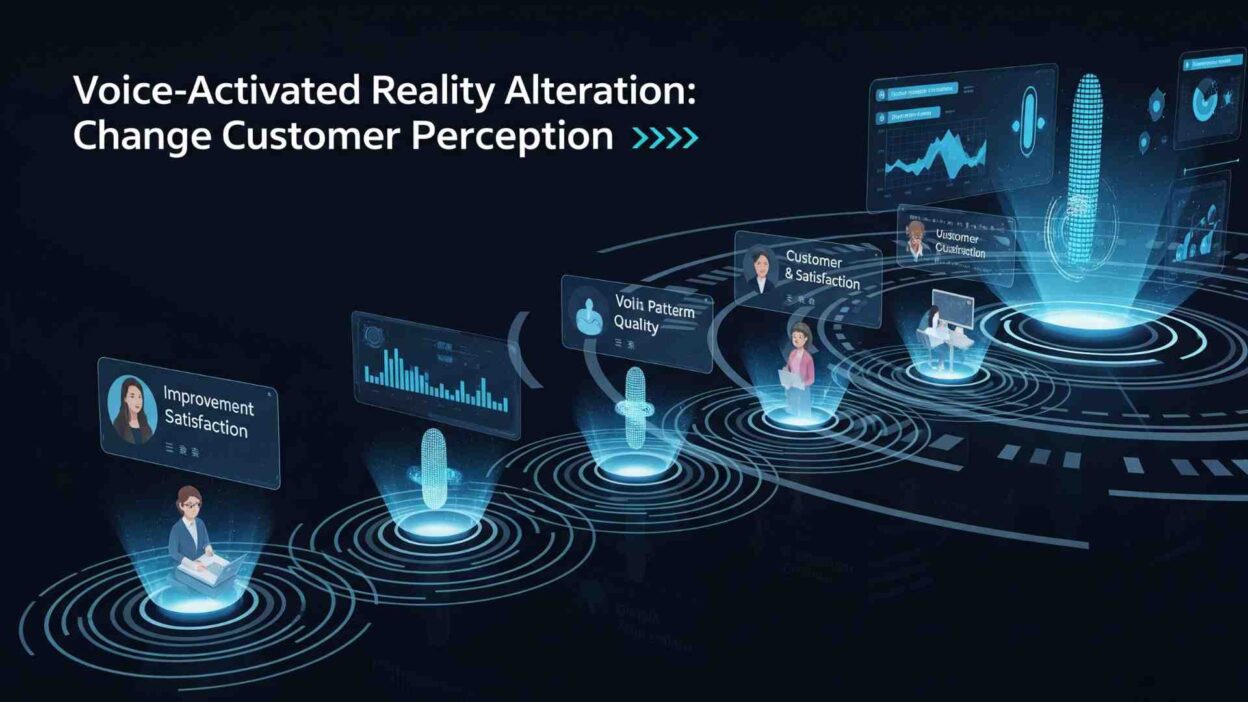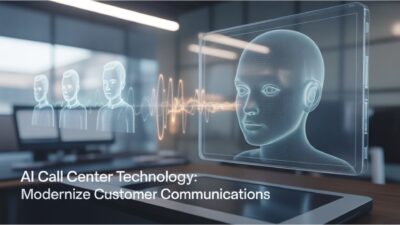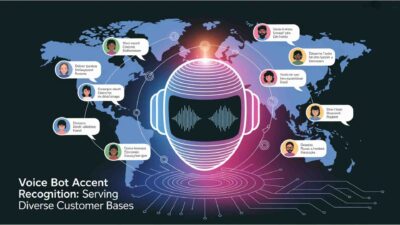Keywords – Voice-activated reality alteration
Table of Contents
Voice-activated reality alteration represents a groundbreaking approach to transforming customer experiences through immersive technology. This innovative system uses voice commands to modify perceived reality in real-time. Businesses can reshape customer perceptions through strategic voice-controlled environmental changes. The technology combines augmented reality with voice recognition to create dynamic customer interactions. Voice-activated reality alteration opens new possibilities for customer engagement and brand experiences.
Understanding Voice-Activated Reality Alteration
Voice-activated reality alteration systems respond to spoken commands by modifying visual and auditory environments. The technology uses advanced voice recognition algorithms to interpret customer intentions. Real-time processing enables immediate reality modifications based on voice inputs. Augmented reality overlays change dynamically according to voice commands. The system creates personalized reality experiences for each customer.
Traditional customer experiences remain static and unchanging. Voice-activated reality alteration adapts environments to individual preferences instantly. Customers can verbally request modifications to their surroundings. The technology responds with appropriate visual and auditory changes. This creates highly personalized and engaging customer experiences.
The Technology Behind Reality Modification
Voice-activated reality alteration combines multiple advanced technologies seamlessly. Speech recognition systems analyze vocal patterns and command structures. Machine learning algorithms interpret customer intentions accurately. Augmented reality engines render visual modifications in real-time. The system synchronizes all components for smooth reality transitions.
Advanced sensors track customer movements and positioning continuously. The technology maintains spatial awareness throughout reality alterations. Voice commands trigger specific environmental modification protocols. Computer vision systems ensure realistic integration of virtual elements. The result is seamless blending of real and modified reality.
Voice Recognition and Environmental Control
Voice recognition systems must understand natural language commands accurately. The technology processes various accents and speaking styles effectively. Machine learning models train on diverse voice datasets continuously. Recognition accuracy improves through ongoing customer interactions. The system adapts to individual speech patterns automatically.
Environmental control systems respond to voice commands instantaneously. Lighting adjustments occur based on verbal requests. Temperature modifications happen through voice activation. Sound environments change according to customer preferences. The technology creates responsive and adaptive physical spaces.
Applications in Customer Experience Enhancement
Retail environments utilize voice-activated reality alteration for immersive shopping experiences. Customers can verbally request product demonstrations and modifications. The technology displays products in different colors and configurations instantly. Virtual try-on experiences respond to voice commands naturally. Shopping becomes more interactive and engaging through voice-controlled reality.
Hospitality industries implement voice-activated reality alteration for personalized guest experiences. Hotel rooms adapt to guest preferences through voice commands. Restaurants modify their ambiance based on customer vocal requests. The technology creates unique and memorable experiences for each visitor. Guest satisfaction increases through personalized reality modifications.
Marketing and Brand Engagement
Voice-activated reality alteration transforms marketing campaigns and brand interactions. Customers can interact with brand messages through voice commands. Product demonstrations become more engaging through reality modifications. The technology creates memorable brand experiences that increase customer loyalty. Marketing messages adapt to individual customer preferences automatically.
Interactive advertising campaigns utilize voice-activated reality alteration effectively. Customers can explore products through voice-controlled demonstrations. The technology provides detailed product information based on vocal inquiries. Purchase decisions become easier through interactive reality experiences. Conversion rates improve through engaging voice-activated presentations.
Entertainment and Experience Design
Entertainment venues deploy voice-activated reality alteration for immersive experiences. Theme parks create interactive attractions responding to visitor voice commands. Museums offer personalized educational experiences through voice-controlled exhibits. The technology adapts content to individual learning preferences automatically. Visitor engagement increases through personalized reality modifications.
Gaming environments integrate voice-activated reality alteration for enhanced gameplay. Players can modify game environments through voice commands. The technology creates dynamic gaming experiences that adapt to player preferences. Virtual worlds respond to vocal interactions naturally. Gaming becomes more immersive through voice-controlled reality modifications.
Technical Implementation and Requirements
Voice-activated reality alteration requires sophisticated hardware and software integration. High-performance processors handle real-time voice processing and reality rendering. Advanced microphones capture voice commands accurately in noisy environments. Graphics processing units render complex augmented reality overlays smoothly. The system demands significant computational resources for optimal performance.
Network infrastructure must support low-latency communication between system components. Real-time voice processing requires minimal delay for natural interactions. Cloud computing provides scalable processing power for complex reality modifications. Edge computing reduces latency for immediate voice command responses. The infrastructure must handle multiple simultaneous voice-activated reality alteration sessions.
Software Architecture and Development
Modular software architecture enables flexible voice-activated reality alteration implementations. Voice recognition modules process incoming audio streams continuously. Reality modification engines handle environmental changes based on voice commands. User interface components provide feedback and control options. The architecture supports real-time processing and immediate response capabilities.
API integration allows third-party applications to utilize voice-activated reality alteration capabilities. Developers can incorporate voice-controlled reality modifications into existing systems. Standard protocols ensure compatibility across different platforms and devices. This accelerates adoption of voice-activated reality alteration technology. Integration complexity reduces through well-designed software interfaces.
Security and Privacy Considerations
Voice-activated reality alteration systems require robust security measures. Voice data contains sensitive personal information about users. Encryption protects voice commands and reality modification preferences. Privacy policies must address voice data collection and usage clearly. Users need control over their voice data and reality modification profiles.
Authentication systems verify user identity through voice patterns. Access control prevents unauthorized reality modifications. The system must distinguish between legitimate and malicious voice commands. Security monitoring detects unusual voice command patterns automatically. This prevents abuse of voice-activated reality alteration capabilities.
Business Benefits and ROI
Voice-activated reality alteration increases customer engagement and satisfaction significantly. Interactive experiences create stronger emotional connections with brands. Customers spend more time in voice-controlled environments. The technology differentiates businesses from competitors effectively. Customer loyalty improves through personalized reality experiences.
Revenue generation opportunities expand through voice-activated reality alteration. Premium experiences command higher prices from customers. The technology enables new service offerings and business models. Upselling becomes more effective through interactive demonstrations. Customer lifetime value increases through enhanced experiences.
Competitive Advantages
Early adopters of voice-activated reality alteration gain significant competitive advantages. The technology attracts customers seeking innovative experiences. Media coverage increases through unique voice-controlled offerings. Market positioning improves through technological leadership. Customer acquisition costs decrease through word-of-mouth marketing.
Operational efficiency improves through automated voice-controlled systems. Staff requirements reduce through self-service voice interactions. The technology handles multiple customers simultaneously without human intervention. Scalability increases while maintaining consistent service quality. This reduces operational costs while improving customer satisfaction.
Customer Data and Analytics
Voice-activated reality alteration generates valuable customer data and insights. Voice patterns reveal customer preferences and behaviors. The system tracks which reality modifications customers prefer. This data improves product development and marketing strategies. Customer segmentation becomes more precise through voice analysis.
Predictive analytics identify customer needs before they express them verbally. The technology can suggest reality modifications based on customer history. This creates more proactive and personalized customer experiences. Business intelligence improves through voice-activated reality alteration data. Strategic decisions become more informed through customer voice analytics.
Future Developments in Voice-Controlled Reality
Artificial intelligence will enhance voice-activated reality alteration capabilities significantly. AI systems will understand context and emotion in voice commands. The technology will predict customer needs more accurately. Machine learning will personalize reality modifications automatically. Voice-activated reality alteration will become more intuitive and responsive.
Integration with Internet of Things devices will expand voice-controlled reality capabilities. Smart environments will respond to voice commands comprehensively. The technology will control multiple systems simultaneously through voice activation. This creates seamless and immersive reality modification experiences. Voice-activated reality alteration will become ubiquitous in smart environments.
Emerging Technologies Integration
Brain-computer interfaces may integrate with voice-activated reality alteration systems. Direct neural signals could supplement voice commands for reality modifications. This would create more precise and immediate reality changes. The technology could respond to subconscious thoughts and preferences. This represents the next evolution in voice-controlled reality systems.
Haptic feedback systems will enhance voice-activated reality alteration experiences. Customers will feel physical sensations corresponding to reality modifications. This creates more immersive and convincing reality alterations. Touch feedback reinforces visual and auditory modifications. The technology will engage more human senses simultaneously.
Industry Transformation Potential
Voice-activated reality alteration will transform multiple industries fundamentally. Retail experiences will become fully interactive and personalized. Education will adapt to individual learning styles automatically. Healthcare will provide personalized treatment environments. Entertainment will create unprecedented immersive experiences.
Workplace environments will adapt to employee preferences through voice commands. Meeting rooms will configure automatically based on participant needs. The technology will improve productivity through personalized work environments. Office spaces will become more flexible and responsive. This will enhance employee satisfaction and performance.
Implementation Strategies and Best Practices
Successful voice-activated reality alteration implementation requires careful planning and execution. Businesses must understand customer needs and preferences thoroughly. The technology should enhance existing experiences rather than replace them entirely. Training staff on voice-controlled systems ensures smooth operation. Customer education helps maximize technology adoption and satisfaction.
Pilot programs allow businesses to test voice-activated reality alteration effectively. Small-scale implementations identify potential issues before full deployment. Customer feedback guides system refinement and improvement. Iterative development ensures optimal performance and user satisfaction. This approach minimizes risks while maximizing benefits.
Measuring Success and ROI
Key performance indicators must be established for voice-activated reality alteration projects. Customer satisfaction scores track experience quality improvements. Engagement metrics measure interaction levels with voice-controlled systems. Revenue impact demonstrates financial benefits of reality modification technology. These metrics guide ongoing system optimization and development.
A/B testing compares voice-activated reality alteration with traditional experiences. This provides quantitative evidence of technology benefits. Customer behavior analysis reveals preferences and usage patterns. The data informs future development priorities and improvements. Continuous measurement ensures ongoing success and optimization.
Challenges and Solutions
Technical challenges include voice recognition accuracy in noisy environments. Advanced noise cancellation algorithms improve command recognition. Machine learning models adapt to various acoustic conditions automatically. The system must distinguish between intentional commands and casual conversation. Continuous improvement addresses these technical limitations.
Cost considerations affect voice-activated reality alteration adoption rates. Initial investment requirements can be substantial for comprehensive implementations. Cloud-based solutions reduce upfront hardware costs. Subscription models make the technology more accessible to smaller businesses. Return on investment justifies initial expenditure through improved customer experiences.
Market Outlook and Future Opportunities
The voice-activated AR/VR market shows tremendous growth potential. Consumer demand for personalized experiences drives technology adoption. Businesses seek competitive advantages through innovative customer engagement. Investment in voice-controlled reality systems is accelerating rapidly. Market expansion will continue as technology costs decrease.
Industry partnerships will accelerate voice-activated AR/VR development. Collaboration between technology providers and end-users improves solutions. Standards organizations will establish protocols for voice-controlled reality systems. This ensures interoperability and accelerates market adoption. The technology will become mainstream within the next decade.
Read More: The Influence Of AI On Cold Calling And New Sales Strategies
Conclusion

Voice-activated reality alteration represents a revolutionary approach to customer experience transformation. The technology enables businesses to create personalized and engaging interactions through voice commands. Customer perceptions can be modified in real-time based on individual preferences. Early adoption provides significant competitive advantages in evolving markets. Investment in reality modulation via voice positions businesses for future success. The technology will fundamentally transform how customers interact with brands and environments. voice-activated AR/VR will become essential for competitive customer engagement strategies.






[…] Read More: Voice-Activated Reality Alteration: Change Customer Perception […]
[…] Read More: Voice-Activated Reality Alteration: Change Customer Perception […]
[…] Enterprise voice AI implementation requires careful planning and systematic execution for successful deployment. Organizations must evaluate their specific needs before selecting voice AI solutions. Voice technology can transform customer interactions and internal processes significantly. Proper implementation ensures maximum return on investment and user adoption. […]